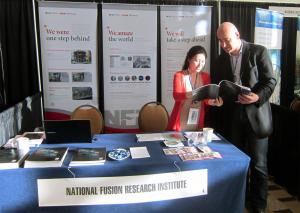Nearly 1,000 of the world's preeminent fusion researchers from 45 countries gathered last week in San Diego to discuss the latest advances in fusion energy. The 24th International Atomic Energy Agency Fusion Energy Conference, organized by the IAEA in cooperation with the U.S. Department of Energy and General Atomics, aims to "provide a forum for the discussion of key physics and technology issues as well as innovative concepts of direct relevance to fusion as a source of nuclear energy.''
Those in attendance in San Diego included Nobel Prize-winning physicist Burton Richter; Physicist Steven Cowley, CEO of the United Kingdom's Atomic Energy Authority; Frances Chen, a plasma physicist and UCLA professor emeritus who wrote the book An Indispensable Truth: How Fusion Power Can Save the Planet; and keynote speaker William Brinkman, director of the Office of Science in the US Department of Energy.
ITER Director-General Motojima gave the overview talk in the opening scientific session on Monday 8 October and ITER played centre stage throughout the conference, with more than 20 members of staff present providing as many scientific papers and posters (the ITER Domestic Agencies, for their part, contributed 54 papers to the conference).
While acknowledging the difficulties in the implementation of the project which the ITER Organization and Domestic Agencies are tackling, delegates to the conference welcomed the significant technical progress in ITER design and construction activities which were reported in the ITER presentations.
At a "Town Meeting" on the prospects for burning plasma studies at ITER that was arranged by the local organizers of the conference, presentations by Rich Hawryluk (Deputy Director-General and director of the Department for Administration) and David Campbell (director of the Plasma Operation Directorate) were particularly well received.



